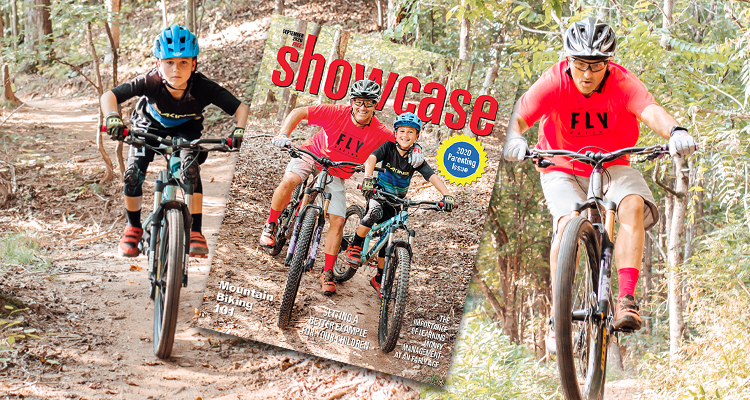Riding a bike may be a rite of passage for most children, the first source of freedom and independence for many. But what about leaving the safe passageways of sidewalks, streets and parking lots and venturing off-road?
How young is too young to take up mountain biking?
Andy DeVault, a former competitive cyclist, helps train mountain bikers for the Angler’s Ridge Trail Association, which helps with trail maintenance, creates and hosts events for bikers. DeVault says that while everyone is different, virtually anyone can begin mountain biking as long as they have the basic principles of biking down.
“The great thing about riding bikes is that it’s one of those activities that you can do at any age and any ability level,” he says. “It’s one of those family-friendly, enjoyable activities.”
DeVault says the Danville area is lucky enough to have one of the best trail systems in Virginia, which makes the region ideal for teaching potential mountain bikers.
“We want to promote the sport to those little ones,” he says, “and we have to have the terrain and territory to do that.”
While many would imagine that biking is biking regardless of the terrain, DeVault begs to differ. That’s where the ATA comes in.
“Most kids who have a bike will ride around the neighborhood,” DeVault says. “They know how to balance, they know how to use the brakes, and typically they know how to tool around the neighborhood.”
With mountain biking, there is “a little bit more inherent risk” being in the woods as opposed to being on pavement, he adds.
Mountain biking also involves greater challenges for young riders.
For example, riders have to learn when and where to change gears. “Very rarely is it consistently flat,” DeVault says.
Mountain biking also involves more standing on the pedals than sitting in the seat.
“When we take kids on the trails for the first time, the first thing we do is make sure they’re up for that,” DeVault adds.
It’s also important to keep the degree of difficulty consistent with the age and ability of the rider.
“You wouldn’t take a first-time skier to the top of the mountain,” DeVault says, which is why it’s best to start on green-level trails.
Although many would assume any street bike is acceptable on a non-paved trail, DeVault suggests that isn’t necessarily the case.
“Any kid can go on a trail on any bike and have fun,” he says, “but there are differences in tires and brakes, so it’s best to use a mountain bike for that.”
But as long as a rider can balance, turn and stop, DeVault notes, a green rider can ride on a green-level trail or paved pathway, such as the Danville Riverwalk.
There are some guidelines the ATA suggests before riding, which includes getting help when selecting a mountain bike.
“A mountain bike can come in all different shapes and sizes,” DeVault says. Bikes are categorized by wheel size, and there are small, medium, and large size bikes within that.
There’s no one-size-fits-all model for what will work for a child or, for that matter, an adult.
The bike needs to be sound, functioning properly and the right size. “You can’t have fun if you’re on a bike that’s way to big or way too small or won’t brake or shift right,” DeVault says.
You want to be able to stand between seat and handlebars with 1-2 inches of clearance above the top bar of the frame, according to DeVault.
It’s also important to be able to easily manipulate the brakes, steer and balance on the pedals.
This also means that operating a mountain bike on a trail requires a different style of riding than on the street. According to a list of tips on the website bicycle.com, one key tactic for traversing a trail is to keep your body loose and fluid. As a rider, your job is to “let the bike do its job” and roll with it. A sturdy stance on top of the handlebars is crucial, and you should “hover” over the seat and allow your bike more room to move the more rough the terrain.
It’s also important to maintain your speed or speed up as necessary, shift your weight depending on the turf in front of you, and go easy on the brakes. It’s also important to use all the gears, according to bicycle.com.
DeVault also stresses that it’s important to have the proper safety equipment—helmet, gloves, knee and elbow pads – for “when the inevitable fall happens. It kind of comes with the territory.”
The ATA is here to provide help for anyone considering taking up mountain biking and to get kids on the trails. The goal is to “gently introduce kids” to the sport, while making sure access is there for all.
“We want it set up that anyone who ventures out into the woods, whether they’re eight years old of 58 years old has a chance to ride,” DeVault says.
“Being on a bicycle to a kid is not only this sense of freedom and independence, it’s just a ton of fun,” he adds.
DeVault noted that activity on the Danville trail system is picking up in the wake of the COVID-19 pandemic, as more families are using biking as an escape. That’s partially due to opportunity, but also because the Danville trail system is “as good as any in the state,” he says.
“The bicycle and outdoor industries are booming right now, so families can do things that allow them to be out while avoiding crowds,” DeVault says, which means more young riders are getting a start on trails.
“The number one thing we can encourage kids is to get out there and have fun,” DeVault says. “There’s really nothing more gratifying to me than to see a kid progress as a biker.”
For more information on local trails, events and help getting on a bike, contact the ATA on Facebook at https://www.facebook.com/AnglersRidgeTrails. To learn more about how to select a mountain bike, contact Rob Collie at the Bicycle Medic at 434-799-3133









